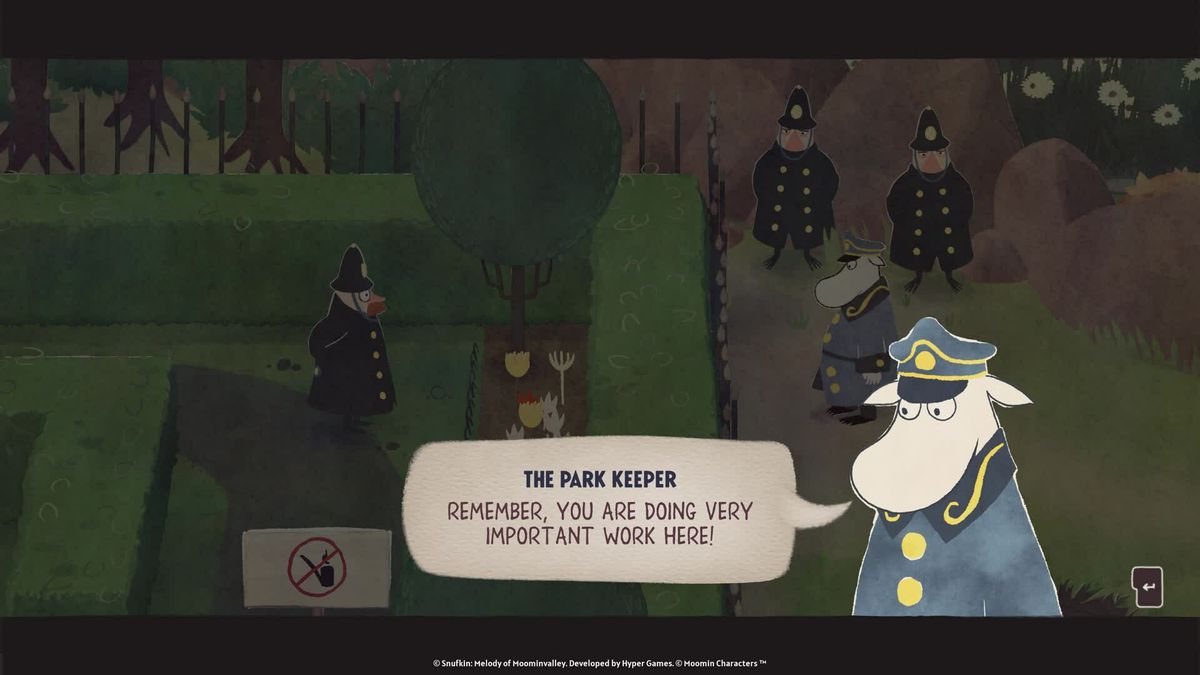Snufkin: Melody of Moominvalley emphasizes Moomin’s anti-authoritarian streak
There are no rules in Moominvalley – or at least that’s not the intention. No one can oversee the wondrous boundaries of nature and the creatures that call the harmonious landscape home. So when a self-appointed Park Keeper and his gang of police officers start creating manicured parks with manicured hedges, gates and (worst of all) rules, Moominvalley begins to descend into chaos. Everything that was once good and peaceful is being disrupted. When Snufkin returns from an adventure in a faraway land, Moominvalley is unrecognizable and his best friend Moom is missing, having been arrested and thrown into a cage while trying to stop this demise.
Before I started, I was little familiar with the Moomins, the characters created by Tove Jansson Snufkin: Melody of Moomin Valleythe game just released by Norwegian studio Hyper Games. Melody of Moomin Valley is loosely based on the fifth Moomin book, Moominsummermadness, which was published in 1954. It’s just part of a vast archive of Moomin media: there are now five video games, several theme parks, TV series and films, books and comics. Even if, like me, you don’t know the Moomins very well, you’ve probably seen them. They are cute, round hippo-like characters who live in the idyllic Moomin Valley and value friendship, love, curiosity and nature.
Image: Hypergames/Raw Fury
Our main characters, Snufkin and Moomintroll, are adventurers and good-hearted troublemakers, making them the perfect duo to lead Melody of Moomin Valley. You could also describe them as subversive, anti-authoritarian anarchists – something that surprised me when I first started the game, but that seems to be in line with the franchise in general.
When you think of anarchy, you may think of chaos and lawlessness, but that is not reality. Anarchism is rooted in anti-capitalism, and that often includes building communities that prioritize mutual aid, equality, and anti-fascism outside the state system. You see this ideology reflected Melody of Moomin Valley almost immediately. The game opens with the surreal sounds of Icelandic post-rock band Sigur Rós as Snufkin returns to the Moomin Valley to find it in disrepair. The community is struggling, and even worse, his friend is in jail. Equipped with a harmonica and other simple instruments, Snufkin sets out to discover what happened, pulling up signs implying things like “don’t sniff flowers” to return wildlife to high-altitude parks while evading the police . In terms of gameplay, this means navigating Snufkin through simple environmental puzzles that largely involve moving rocks to create paths or finding little critters to climb high walls. The instruments are also useful in these situations, whether it is luring something out of a hole or sending crabs or spiders away.
There’s not much to do, and that’s part of the appeal, something akin to Adam Robinson-Yu A short walk. (That comparison seems logical because Robinson-Yu is credited as a design consultant Melody of Moomin Valley.) It’s mostly aimless exploration, following paths only to hit dead ends story-wise, but perhaps with a character or two to talk to or help with a small favor. In one case I helped the invisible child Ninny get her clothes back after they were stolen. These will somehow eventually lead back to the path to saving Moomintroll, and thus Moominvalley. (Snufkin’s friend, Little My, also adds a little spice to the adventure.)

Image: Hypergames/Raw Fury
In his more active moments, Melody of Moomin Valley requires me to avoid the police in simple stealth sections. But you largely draw inspiration from nature, which increases the power of the above-mentioned instruments and is necessary to ‘open up’ certain areas. Finding this inspiration is as easy as running through a bush or a field of flowers, and it encourages you to look even into the game’s dead ends. My biggest complaint is that for a game with “melody” in the name, the instrument mechanics are a bit underutilized. Yes, it’s important to ‘unlock’ certain areas and progression, but it feels more like an add-on than a core focus.
This is a mechanically straightforward game, meaning children can explore the world with ease, while older players can take comfort in the cozy nature of the deliberately slow game. If you’re looking for something that will keep you tense or constantly engaged, Melody of Moomin Valley is it not. But if you want something slow, something that appreciates nature and community – with an anti-authoritarian twist – you’ll enjoy these short four hours of Moomin.
Snufkin: Melody of Moomin Valley was released on March 7 on Nintendo Switch and Windows PC via Steam. The game was reviewed on the Nintendo Switch using a download code from Raw Fury. Vox Media has affiliate partnerships. These do not influence editorial content, although Vox Media may earn commissions on products purchased through affiliate links. You can find Additional information about Polygon’s ethics policy can be found here.
